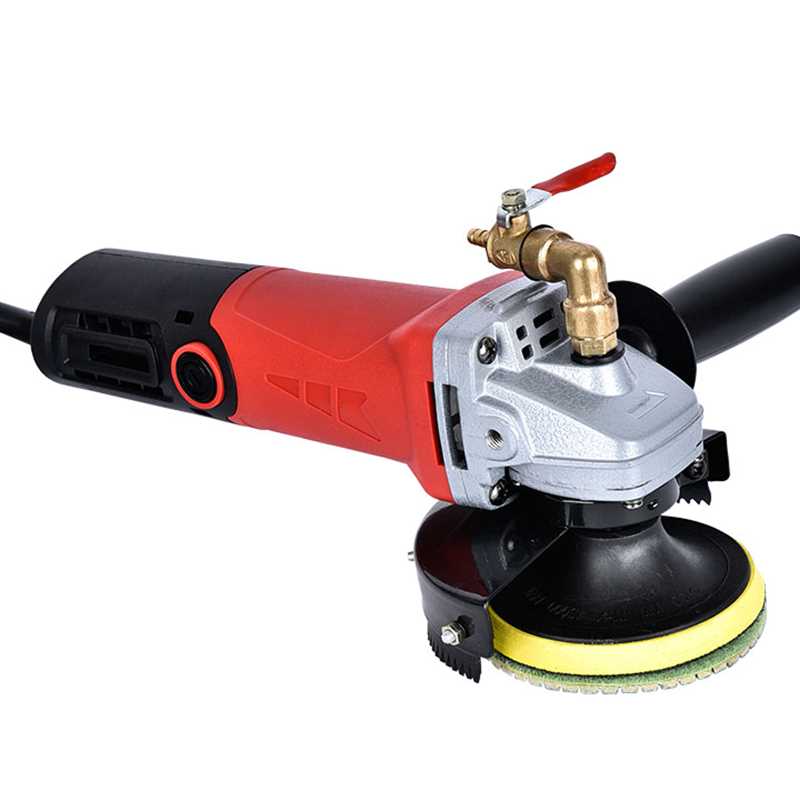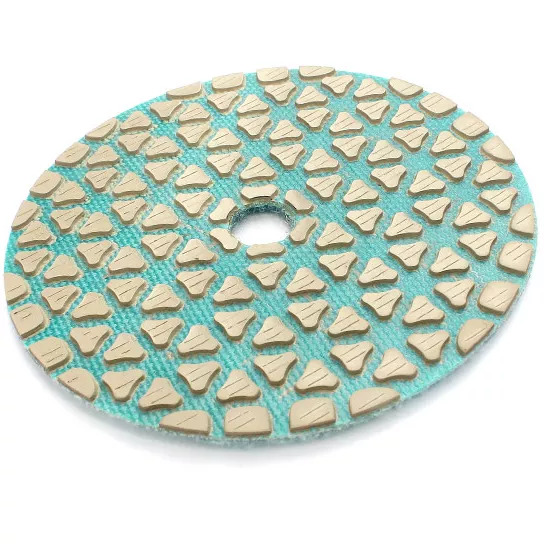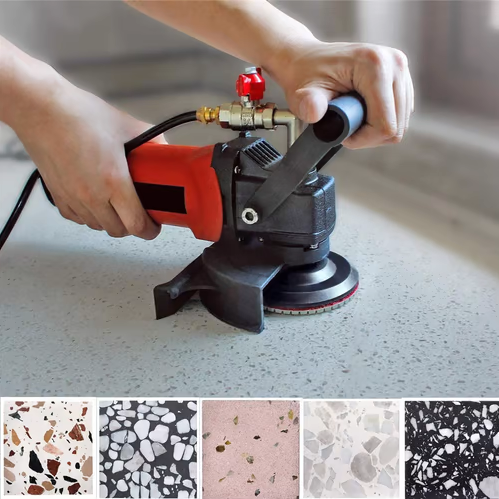Material Science
Stone polishing pads
There are two kinds of polishing stones: resin polishing block; Resin polishing disc.
Polishing of products: put the polishing stone on the processed products, and use the mechanical equipment to operate quickly and “dry polishing and wet polishing” to achieve the polishing effect. The product surface will have strong reflected light, which is commonly referred to as gloss.
Principle
The principle of polishing is mainly reflected in two aspects: the principle of particle grinding; Physical and chemical principles.
1. Particle grinding: when the abrasive particles are from rough grinding to rough grinding and polishing, the grinding trace of the abrasive on the stone surface is from coarse to fine and then to no visible trace. The surface will be smooth, flat and delicate. When the depth reaches 110 microns, the processed surface will appear specular luster, bright and bright.
Particle grinding consists of the following processes:
① Rough grinding: it is required that the grinding tool has a deep cutting edge, high grinding efficiency, rough grinding grain and rough grinding surface. It is mainly to remove the saw blade traces left in the previous process and grind the flatness and modeling surface of the product in place;
② Semi fine grinding: remove the rough grinding marks to form a new fine grain, and the product processing surface is flat and smooth;
③ Fine grinding: the pattern, grain and color of the product after fine grinding have been clearly displayed, the surface is fine and smooth, and there is a weak gloss;
④ Fine grinding: the processed product has no visible trace. The surface is more and more smooth, and the gloss is about 40 ~ 50 degrees;
⑤ Polishing: the surface is bright as a mirror, with a certain specular gloss (above 85 degrees).
2. Physicochemical principle: there are two polishing processes, namely “dry polishing and wet polishing”. When the stone products have physical and chemical effects between “dry and wet”, the dry polishing is to evaporate the water when the temperature of the stone surface rises, resulting in an increase in the concentration of the polishing stone, so as to achieve the strengthening effect. The gloss of the product begins to meet the ideal requirements, and the gloss reaches more than 85 degrees or higher.
The polishing stone is polished on the processed products. After the polished products are hot, add water to the plate surface to reduce the temperature. It is not allowed to add water continuously or add a large amount of water. Otherwise, the lubrication effect of water will make the polishing not reach the ideal effect, and dry polishing cannot be used. The excessive temperature will burn the plate surface and cause cracks on the plate surface.
Generally speaking, after fine grinding, the gloss of the products is about 40 ~ 50. However, some stone materials cannot reach the above gloss after fine grinding, such as Shanxi black, black gold sand, Jining black, etc. the gloss of such products after fine grinding is only 20 ~ 30 degrees. It is not enough to understand the original meaning of grinding with the front particles. This kind of products will strengthen the polishing process and produce physical and chemical reactions when the polishing is “dry and wet” and the temperature rises and drops, After “dry polishing and wet polishing”, the gloss of the product is gradually improved, and the gloss reaches more than 85 degrees.
3 stone polishing equipment professional stone polishing machine

Several factors affecting stone polishing: the polishing effect of stone depends on two aspects: one is the polishing technology adopted, i.e. “acquired” artificial external factors; Second, there are “innate” internal reasons for the stone itself.
If the internal factors of the stone are not considered, the main factors affecting the polishing of the stone are the type of polishing agent, polishing liquid (paste), polishing grinding tools, diamond sanding pads (tools, grinding blocks) and polishing process parameters.
(1) Type of polishing agent
Although polishing agent is a special polishing material, the difference between it and grinding material is mainly manifested in the processing mechanism. In principle, some micro powder materials with low hardness can also be used as polishing agents. But generally, the polishing agent with high hardness is better than that with low hardness and has a wide range of application. Diamond polishing powder can achieve satisfactory polishing effect on most stone materials.
(2) Polishing liquid (paste)
Water is a commonly used polishing liquid. It can not only play the role of grinding cooling, but also serve as the medium of physical and chemical effects in the polishing process.
If the polishing of stone is mainly based on mechanical grinding, such as diamond powder, the polishing liquid is generally oil-based organic liquid, such as sewing machine oil. Its cooling, lubricating and dispersing effects are excellent.
Diamond grinding paste, both water and oil, and can also be added with colorants. The formula is: abrasive + dispersant + carrier + water + colorant.
(3) Polishing disc (tool, grinding block)
The flat stone light panel is a form of expression and processing of stone surface grinding. Hard disks made of metal materials are often used as polishing discs. The polishing surface of floppy disk polishing is easy to yield into a concave surface when the stone is pressed, which is suitable for arc surface polishing. The medium hard disk has good wear resistance and adsorption, and has a certain elasticity. It also has a good polishing effect on flat stone.
(4) Polishing process parameters
The process parameters include the concentration and supply of polishing agent, the pressure and linear speed during polishing. Before the concentration is less than a certain value, the polishing speed increases with the increase of the concentration of the polishing agent. After the concentration reaches the maximum, if the concentration is increased again, the polishing speed decreases. Similarly, when the supply amount of the polishing agent is at a certain value, the polishing speed is maximum, and if the supply amount continues to increase, the polishing speed decreases. Properly increasing the pressure during polishing can increase the polishing speed, but too much pressure will strengthen the grinding effect, which is not conducive to the formation of glossy surface. The polishing speed depends on the rotating speed of the polishing disc (tool), but if the linear speed is too high, the polishing agent will be thrown out, causing waste.
(5) The quality of the previous process and the roughness of the stone surface.
If we consider the internal factors of the stone itself, such as the mineral composition of stone materials, it is mainly manifested in the process characteristics of stone polishing.
① The polishing process characteristics of stones with different mineral compositions are different. For example, stone materials mainly composed of serpentine minerals, such as Dahua green marble, belong to stone materials with strong toughness, which can be polished but not easy to polish.
② Marble contains a certain amount of soil minerals, which will also affect the gloss of stone. A typical example is the red Anhui snail in Anhui. The name of the rock is layer selecting stone biological limestone. The sawn plate on the parallel plane has a flower shaped biological pattern, more like a clam snail, and is very beautiful. However, because the ore contains a certain amount of clay mineral components, it is difficult for the polished plate to achieve a gloss of more than 85.
③ Loose granite is often weathered to a certain extent by Muscovite minerals (clayization or hydromica), and its polishing effect is difficult to reach the polishing level of fresh granite. This should be the quality of the stone.
④ Theoretically, different minerals should use different polishing agents. Polishing is a kind of fine processing technology of stone, and some people call it the surface polishing technology. There are many factors affecting the polishing of stone materials, including the problems of process conditions and parameters in the polishing process, the types of polishing agents, auxiliary materials and polishing discs (tools and blocks), and the mineral composition and quality of stone materials
Post time: Aug-24-2022


